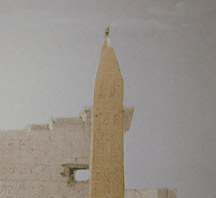

The huge columns of the temple of Karnak dwarfed anything Roberts had seen thus far, nearly 80 feet tall with capitals 50 feet in circumference. He composed a number of views of the great hall, still showing its now faded colors, all of which have become some of the most desired lithographs. (View the lithographs of Karnak.)
At Luxor he took special pains to depict the hawk that perched atop the great obelisk as he sketched, chasing away the intrusive pigeons from the surrounding dovecotes. (View the lithographs of Luxor.)

The area of Luxor and Karnak, known as ancient Thebes, was several times the capital of ancient Egypt in the Middle and New Kingdoms, and has perhaps the most impressive concentration of temples and ruins in Egypt, built during the nearly 500 year height of its glory, from 1580 to 1085 B.C. During this time the metropolis reached the astounding population of nearly a half million people.
Roberts spent a total of ten days in the area, crossing the Nile to sketch the tombs of the Valley of the Kings, the Colossi of Memnon, and the funeral temple of Ramses II (known as the Memnonium.) Of the approximately 125 lithographs of Egypt and Nubia ultimately produced by Roberts, 25 are of Luxor, Karnak and Thebes, attesting to the importance of this area as an ancient Egyptian religious and cultural center. (View the lithographs of Memnon.)
Roberts continued on to Dendera, and from there set sail for Cairo, arriving after nearly two weeks of uninterrupted travel.